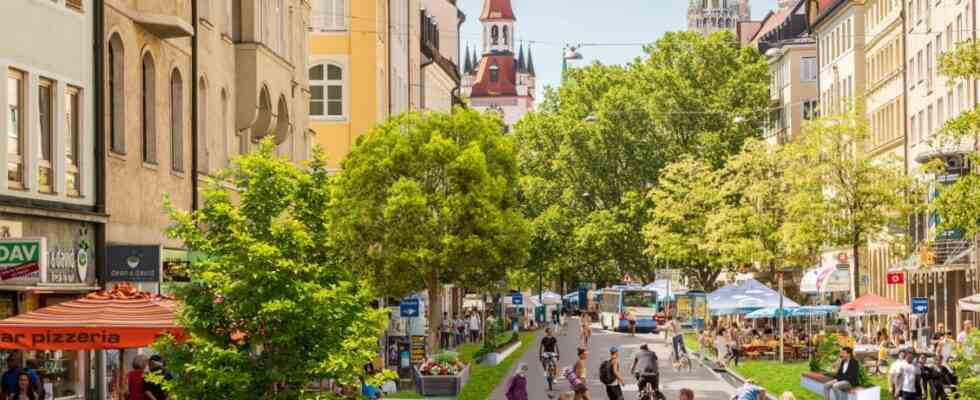When the Munich pedestrian zone was introduced almost exactly 50 years ago, it was a turning point in Munich’s transport policy. It meant turning away from the completely car-friendly inner city. After various extensions, including in Sendlinger Strasse, the valley is set to become a pedestrian zone as early as next year. On Friday, the parliamentary groups of the Green/Pink List and SPD/Volt presented their proposal to redesign the valley soon.
Among other things, it envisages many unsealed green spaces, outdoor seating areas, more trees and fountains and – if feasible – even a small stream. All of this should ensure a more pleasant urban climate and more quality of stay between Marienplatz and Isartor. Cars are to be largely banned from this area, and 29 parking spaces in the valley are to be deleted.
The idea of a pedestrian or traffic-calmed zone in the valley is older. Originally, however, the city wanted to wait with the redesign until the construction work on the future Marienhof S-Bahn station was completed, since the access route for trucks leads through the valley according to the planning approval decision. A temporary solution should be implemented first.
From the point of view of the factions, the conditions have now changed. Because the second main line of the S-Bahn should initially be finished in 2026, and then in 2028 after rescheduling. According to new findings, the work will now last until at least 2033, and according to estimates by the Bavarian Ministry of Transport even until 2037 – eleven years longer than indicated at the groundbreaking ceremony in April 2017. The green-red town hall coalition does not want to wait that long. Therefore, the city administration should now develop a proposal for the conversion and implement it structurally in 2023. The same should also happen in Westenriederstrasse. Truck traffic to the Marienhof could then be routed via Maximilianstrasse.
Pedestrian, bicycle and car traffic still mix in the valley.
(Photo: Stephan Rumpf)
The SPD also spoke to the citizens’ initiative (BI) Tal in advance. She had opposed the plans to simply delete all parking spaces. But the ideas that are now available are acceptable, as BI member Roman Roell explains when asked. “We want a healthy reduction in car traffic,” he says. In other words, from the point of view of BI, foreigners who are looking for a short-term parking space for shopping do not need it. Pitches for those who live there, but already. “If we really get residents’ parking spaces, things will be defused,” says Roell.
Some of BI’s ideas have been taken up in the application. There should be a parking concept and parking zones for residents between Maximilianstrasse and Westenriederstrasse. Access in this area should only be permitted to residents, traders, taxis and people with restricted mobility – primarily for doctor visits. As in the rest of the pedestrian zone, there should be time-limited delivery options as well as additional delivery zones in the adjacent streets.
An idea that SPD traffic expert Nikolaus Gradl has already promoted and that has now been taken up is a shuttle service with small, electrically powered buses throughout the pedestrian zone. It is also to be examined how bicycle traffic can roll through the valley all day long, analogous to the butcher mile at the Viktualienmarkt. A bicycle lane that could also be used by minibuses would be conceivable.
According to Gradl, talks are being held with the Munich transport company (MVG). Money will be made available for the purchase of electric shuttle buses. For example, the 18-meter-long articulated buses on route 132 could be kept out of the valley. Green party leader Mona Fuchs imagines the valley as a new flagship for the city. However, the project should not be implemented without renewed public participation. “When there are major changes, we have to do politics with the people and not over their heads,” says SPD parliamentary group leader Anne Hübner.

